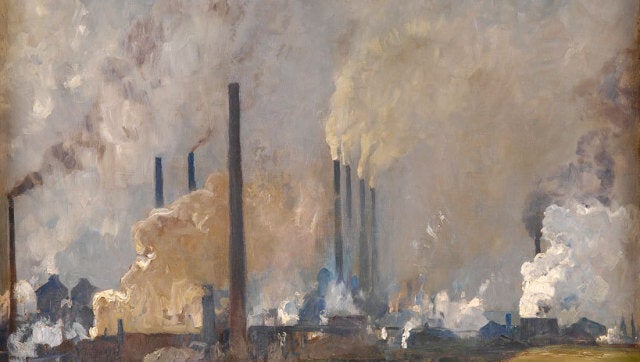
As developing countries from Peru to China become industrialized, millions of tons of toxic pollution are being spread around by batteries, factories and mines -- placing at least 125 million people at risk of death or disease, according to a new report by two non-governmental organizations.
After hundreds of additional pollution sites were discovered this past year, the report said it "currently estimates that the health of some 125 million people is at risk from toxic pollution globally."This is up from previous estimates that 100 million people were at risk, said the report by Blacksmith Institute of New York and Green Cross Switzerland, entitled: "The World's Worst Pollution Problems.""Life-threatening pollution will likely increase as the global economy exerts an ever-increasing pressure on industry to meet growing demands," said Richard Fuller, CEO of Blacksmith.
The number of people at risk of death and disease from pollution is greater than those suffering from malaria and close to those afflicted by HIV/AIDS and other diseases, according to the report. Since the 1950s, the United States, Europe and Japan have devoted enormous resources to cleaning up toxic wastes at home and issued regulations to ensure that clean production keeps toxic materials away from their citizens. But low and middle income countries have yet to find the money, know-how and will to end toxic pollution.
"The Organization for Economic Cooperation and Development (OECD) has estimated that the global output of chemicals in 2020 will be 85 percent higher than in 1995, and nearly one-third of the production will take place in developing countries, compared to about one-fifth in 1995," said the report.
The most common pollutants are lead, chromium, mercury, cadmium, asbestos and volatile organic compounds, said report authors in a teleconference in October.
According to the report, "the impact on health in low and middle income countries from these sites is... likely higher than in the developed world." This is due to:
- Poor regulation and oversight of industry
- Poor control of hazardous wastes and poor technology
- Hazardous industries close to cities
- Communities and industry lack understanding of health impacts from waste
- Small-scale polluters lack funds to curb wastes
"In the last year Blacksmith Institute investigated hundreds of new sites," said Jack Caravanos, associate professor and program director of Environmental and Occupational Health Sciences at Hunter College in New York. "Now we have identified over 2,600 sites and we are working on their health impacts. We focus on mines and dump sites and the villages near those sites."
Caravanos noted that there are some countries where it is unsafe to investigate pollution problems, such as Afghanistan and some Middle Eastern countries.
"We always work with local governments," he said. "In some cases governments are less cooperative and we can't work there. We are nowhere near getting to a majority of sites. Our numbers are conservative.
"The key finding of this report is that the number of people at risk is over 125 million." Little has been known about the health impact of lead, chromium and other heavy metal wastes in developing countries, in part because it takes years to determine that exposed children have suffered brain or other neurological damage. Infectious diseases are far easier to identify and record and therefore have garnered the lion's share of funding and research. "Pollution is less clear -- it is subtle," said Caravanos. "Impaired cognitive function from lead in children is not seen until puberty, years after exposure to lead."
The report measures the health impact from toxic exposure in terms of Disability Adjusted Life Years (DALYs). DALYs represent the sum of two other calculations, Years of Life Lost (YLL) and Years Lost to Disability (YLD). The report estimated that in the past year in the developing world, industrial pollution has caused 17 million DALYs. It compared that to 34 million DALYs from tuberculosis, 29 million from HIV/AIDS and 14 million from malaria.
"We have created the most comprehensive data base in the world" on toxic sites in low and middle income countries according to Bret Erickson, head of Blacksmith's site assessments team. His team began work in 2009 with support from the UN, EU, Asian Development Bank, World Bank, Green Cross and others. It is operating in 49 countries. The team hires local experts and trains them to collect data in a consistent way. Samples of soil and water are sent to labs for testing for the six pollutants they are focused on -- the most widespread, most dangerous and the easiest to measure.
Erickson said that the 2,600 toxic sites it has found around the world is a very conservative number since the United States alone has an estimated 100,000 to 300,000 toxic pollution sites. When asked what kind of funding is needed to clean up the toxic sites identified in the report, John Keith of Blacksmith said: "As much as we can get. We think a global source of funding to address this needs to be established. But a global fund won't solve all the problems. Each country will have to address these problems. But a fund of $100 million to $300 million will go a long way [in funding] demonstration projects and getting awareness of problems out there, getting government attention."
The Top Ten List of pollution sources by DALY are:
1. Lead-Acid Battery Recycling: 4,800,000 DALYs2. Lead Smelting: 2,600,0003. Mining and Ore Processing: 2,521,6004. Tannery Operations: 1,930,0005. Industrial/Municipal Dump Sites: 1,234,0006. Industrial Estates: 1,060,0007. Artisanal Gold Mining: 1,021,0008. Product Manufacturing: 786,0009. Chemical Manufacturing: 765,00010. Dye Industry: 430,000
Stefan Robinson of Green Cross noted that there are also four to ten million tons of pesticides in dump sites and it would require billions of dollars to move them to incineration plants.
One problem in cleaning up or even reporting on pollution sites is that it is "politically sensitive," said Keith. "It is a trade-off between the environment and economic growth... Some countries worry about economic competitiveness. The cost of environmental controls may make them uncompetitive." Keith noted that you cannot say these countries don't care about pollution. But they feel they can't afford to restrict industrial production.
Ben Barber is a communications advisor to Blacksmith Institute.
